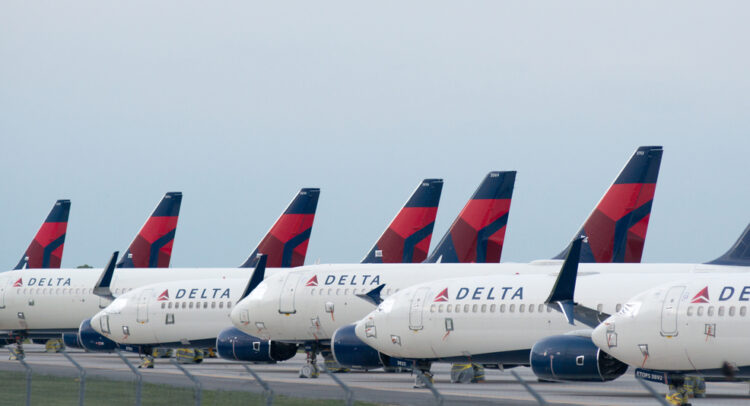First I would like to address the question in the title using two words – Probably yes – DAL stock is starting to look really cheap.
Delta Air Lines (DAL) stock has been rocked by a tech outage and certain factors within the company’s Q2 earnings, namely moderating unit revenue. Despite mixed results, albeit generally positive, it’s hard to ignore the company’s attractive valuation, supportive trends from falling interest rates, and normalizing inflation. For those reasons stated, I remain bullish on Delta.
Delta’s Unit Revenue Moderates
To fully grasp Delta’s attractive valuation, we must first examine its financial state and the more fragile aspects of its operation.
Delta Air Lines, one of the world’s largest airlines by fleet size and capacity, recently released its second-quarter earnings report. While the company beat revenue expectations, some analysts have raised concerns about falling unit revenue.
Delta reported operating revenues of $16.66 billion for the quarter, a 7% increase compared to the previous year, exceeding analysts’ expectations of $15.7 billion. Adjusted earnings per share (EPS) came in at $2.36, slightly below the anticipated $2.37.
However, during the period, we saw the Atlanta-based airline increase its capacity by an impressive 8%, but this wasn’t matched by passenger revenue, which grew at 5%. This suggests a softening of unit revenues and potentially weakening demand.
This softening was seemingly most apparent on Latin American routes. Revenue here grew by just 4% versus a 19% expansion in capacity. However, this relationship between revenue and capacity growth was seen across most markets, albeit more apparent in some than others.
What does this tell us? It reinforces the idea that air fares are moderating. In July, CPI data highlighted that air fares had fallen for the fourth month in a row. Notably, fares in the U.S. were down 5.1% in June compared to a year ago on an unadjusted basis.
Despite Delta’s emphasis on premium services and loyalty programs, premium seat sales rose by 10%. The company is not immune to these industry trends. Speaking in July, Delta Chief Executive Officer Ed Bastian said, “Excess supply has led to heavy discounting (…) Like everyone, you get impacted.”
As such, moving forward, Delta and its peers will likely increasingly focus on keeping unit costs low to preserve margins.
Delta’s CrowdStrike Costs
Another factor impacting Delta’s relatively cheap price besides its softer unit revenues is the aftermath of the global tech outage linked to a CrowdStrike (CRWD) update in July.
This disruption led to the cancellation of approximately 7,000 flights over five days, impacting around 1.3 million passengers. Bastian said that such prolonged disruption is unacceptable, adding that “our customers and employees deserve better.”
The financial impact is substantial, with an estimated $380 million revenue loss in Q3 due to customer refunds and compensation. Delta is now pursuing legal action against CrowdStrike and Microsoft (MSFT) to recover at least $500 million in damages.
Delta has detailed $170 million of non-fuel expenses related to customer reimbursements and crew costs, although Delta saved $50 million in fuel expenses due to the reduced number of flights. The company also said it expected growth from the quarter to September to be impacted by 1.5 points.
Is Delta Stock Really That Cheap?
Since the CRWD outage, Delta stock has fallen by 15.3%. However, this has made the stock appear cheaper compared to medium-term earnings expectations, which has increased my bullishness of its value.
The airline is currently trading at 6.4x forward earnings, a discount to American Airlines (AAL), which is 9.4x forward earnings. Nonetheless, it’s important to recognize that earnings expectations for 2024 have fallen due to the earnings update and the tech outage. In fact, there have been 16 earnings per share (EPS) downgrades over the past 90 days.
Looking further ahead, analysts expect earnings to improve throughout the medium term, with the price-to-earnings (P/E) ratio falling to 5.4x in 2025, 4.7x in 2026, and 4.1x in 2027. This earnings growth rate leads to a price-to-earnings-to-growth ratio of just 0.73 (a ratio under one tends to suggest undervalued conditions).
What’s more, it’s important to consider supportive trends such as falling interest rates, moderating inflation, and potentially fuel prices. These should, in turn, support demand and aid cost reduction efforts.
Is Delta Stock A Buy According to Analysts?
On TipRanks, DAL is a Strong Buy based on 11 Buys, zero Holds, and zero Sell ratings assigned by analysts in the past three months. The average Delta Air Lines stock price target is $63.07, implying a 59.23% upside potential.
The Bottom Line on Delta Stock
As stated above, I am bullish on Delta, given its relatively cheap valuation and medium-term outlook. Analysts suggest this is one of the most undervalued large-cap stocks, and the valuation metrics support that. With interest rates set to moderate in the U.S. and the share price down considerably over the past month, I believe there could be an opportunity for investors.










